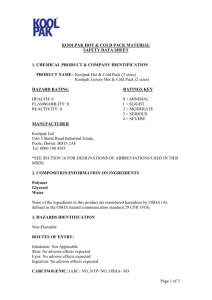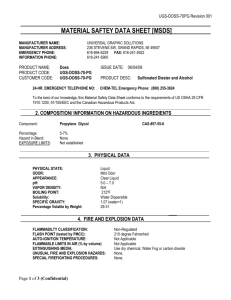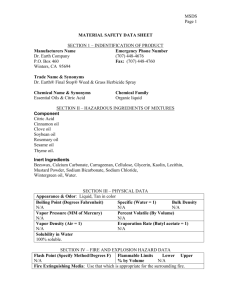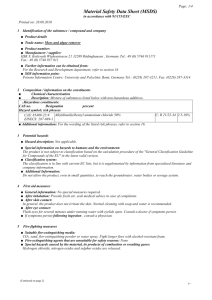MSDS - Fairmont Specialty
advertisement
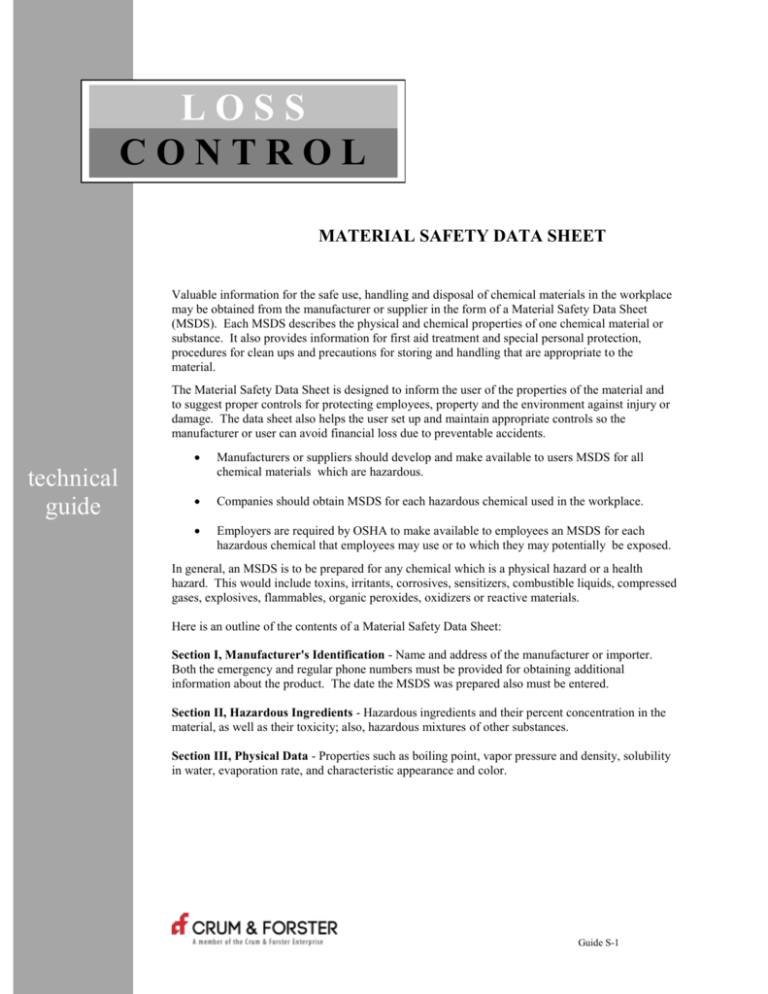
LOSS CONTROL MATERIAL SAFETY DATA SHEET Valuable information for the safe use, handling and disposal of chemical materials in the workplace may be obtained from the manufacturer or supplier in the form of a Material Safety Data Sheet (MSDS). Each MSDS describes the physical and chemical properties of one chemical material or substance. It also provides information for first aid treatment and special personal protection, procedures for clean ups and precautions for storing and handling that are appropriate to the material. The Material Safety Data Sheet is designed to inform the user of the properties of the material and to suggest proper controls for protecting employees, property and the environment against injury or damage. The data sheet also helps the user set up and maintain appropriate controls so the manufacturer or user can avoid financial loss due to preventable accidents. technical guide Manufacturers or suppliers should develop and make available to users MSDS for all chemical materials which are hazardous. Companies should obtain MSDS for each hazardous chemical used in the workplace. Employers are required by OSHA to make available to employees an MSDS for each hazardous chemical that employees may use or to which they may potentially be exposed. In general, an MSDS is to be prepared for any chemical which is a physical hazard or a health hazard. This would include toxins, irritants, corrosives, sensitizers, combustible liquids, compressed gases, explosives, flammables, organic peroxides, oxidizers or reactive materials. Here is an outline of the contents of a Material Safety Data Sheet: Section I, Manufacturer's Identification - Name and address of the manufacturer or importer. Both the emergency and regular phone numbers must be provided for obtaining additional information about the product. The date the MSDS was prepared also must be entered. Section II, Hazardous Ingredients - Hazardous ingredients and their percent concentration in the material, as well as their toxicity; also, hazardous mixtures of other substances. Section III, Physical Data - Properties such as boiling point, vapor pressure and density, solubility in water, evaporation rate, and characteristic appearance and color. Guide S-1 Section IV, Fire and Explosion Hazard Data - Properties such as flash point (method of ignition), auto ignition temperature and lower an upper flammability limits in the air. (This information is very important for materials used near sources of ignition or within poorly ventilated spaces.) Also, means of extinguishment and special procedures for fire fighting. Section V, Reactivity Data - Stability of the material and related conditions to avoid; other materials that are incompatible; hazardous decomposition products; and hazardous polymerization with related conditions to avoid. (This information outlines conditions of use and storage under which the material will remain stable, as well as likely conditions that could cause a dangerous chemical reaction.) Section VI, Health Hazard Data - Routes of entry, acute and chronic health hazards, carcinogenicity, signs and symptoms of exposure, medical conditions aggravated by exposure, and first aid procedures and emergency treatment. (This information offers a guideline for monitoring employee exposure during use of handling. Effects of overexposure and first aid treatment should be covered in employee training sessions.) Section VII, Safe Handling and Use - Recommended actions for safe cleanups and for final disposition without hazard to people, property or the environment. Section VIII, Control Measures - Suggestions covering need for ventilation, respiratory protection, eye protection, and gloves and other protective equipment during exposure to the material. This is to reduce employee exposure to the hazardous material. Guide S-1 The Material Safety Data Sheet presents much useful information for the proper use, storage and disposal of a hazardous chemical material. It is the responsibility of the employer to obtain an MSDS for each hazardous material used in the workplace and to share it with employees. The employer should also institute the appropriate control measures as recommended by the manufacturer of the material or as required by safety regulations. For answers to questions regarding any Material Safety Data Sheet, write or call the manufacturer or supplier of the material or contact your loss control representative or industrial hygiene specialist at the local office of Crum and Forster Insurance. For further details and technical definitions of terms used, as well as the complete OSHA Hazard Communication Standard, see 20 CFR 1910.1200. This information has been developed from sources believed to be reliable. However, since it is a general guide to safety, compliance with all federal, state or local laws and regulations is the policyholder’s responsibility. Guide S-1


